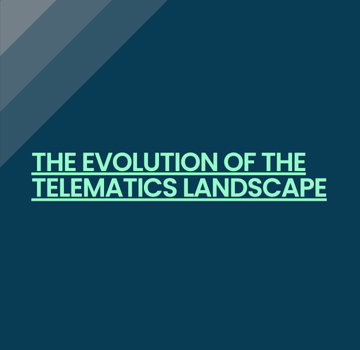|
Talking Telematics is a series of interviews between Philippe Moulin, CEO of DriveQuant, and insurance insiders. The topics are exclusively related to telematics and the benefits of the technology for the motor insurance industry. The following interview is based on a podcast hosted by Florian Graillot, VC at Astorya.io. The transcription has been edited for readability. |
Florian: In this interview, we're going to take a closer look at telematics. Because I have the impression that people are often divided on the topic while it's still a niche market. So we're going to shed some light on all of this with you, Philippe. Could you share with us your definition of telematics?
Philippe: Basically, telematics is the combination of computer science and telecommunications. In the context of the insurance industry, telematics insurance generally refers to car insurance. It’s the use of driving data for insurance purposes - often for pricing purposes.
Driving data is leveraged to modulate the insurance premium based on indicators such as harsh acceleration, hard braking, dangerous turns, and sometimes even excessive speed - in countries where measuring overspeeding is allowed.
Nowadays, there are many telematics services that add value beyond pricing. I am thinking about road safety programs or crash detection services for instance. The driving data can also be used for assistance or claims management enhancements. So telematics impacts the whole insurance value chain.
In the last few years, the term "telematics" has been replaced by the term "connected insurance". And there are very successful connected insurance programs whether in the US or in other parts of the world - such as Discovery in South Africa.
Florian: Let’s focus on the technological aspects. A few years ago, a policyholder was required to install a telematics device in the car, a dongle or a black box, when purchasing a telematics insurance policy. It was a real challenge for insurers. However, now that we all carry a smartphone in our pocket, phones could eventually replace these infamous devices. Can you give us a brief explanation of the technical solutions used over the years?
Philippe: As far as I know, the first telematics insurance program required hardware devices - connected boxes. With these boxes, insurers and policyholders don't necessarily have access to the raw data that is collected. It identifies events or macroscopic indicators. This type of technology can still be found in some specific markets such as Italy.
It is useful for things like the recovery of stolen vehicles. In this case, the boxes are really concealed in the vehicle. The main drawback of this tech is the cost: the cost of the technology itself, manufacturing the box, and the installation costs. So these are solutions that are relevant only in specific markets where insurance premiums are high enough to offset these costs.
Then, another technology is OBD boxes. It’s a lighter solution than connected boxes that use the vehicle OBD port. Originally, this port was developed for diagnostics, mainly for after-sales purposes. So it's a diversion of an existing technology. OEMs don’t appreciate that they're being used for other purposes.
Technically speaking, this tech is hard to deploy. OBD boxes aren’t compatible with all brands and sometimes even within a brand, OBD variations can be found. For policyholders, finding the OBD port can be challenging. And it's not ergonomic to have an OBD box plugged in while driving. So there are many drawbacks. That being said, OBD boxes are cheaper than connected boxes because the policyholder can - theoretically- install the device on its own. Overall, it's not a sustainable solution.
Finally, in the last few years, smartphone technology has been increasingly gaining market shares. The thing is there is a smartphone in every vehicle today, everywhere in the world. Thus, it's a solution that is cheap to deploy and scale.
The driving data collected by smartphones is actually very good. And it’s possible to closely monitor the driving behaviour of a driver and to detect phone distraction, a critical factor for road safety. Smartphones can be combined with a beacon if necessary. It’s a simple Bluetooth transmitter that can contain an accelerometer.
All in all, there’s a trade-off to be made between the cost of the solution, the ease of implementation - which is an indirect cost - and the market. In some niche markets, hardware-based telematics can be a viable option. However, it makes more sense to favour smartphones. It’s a technology that is easier to deploy on a very large scale, and that is much cheaper.
Florian : Connected insurance offers customers new insurance programs. I'm obviously thinking of Pay-As-You-Drive, Pay-How-You-Drive, Pay-When-You-Drive. How are these models different? And are they all about telematics?
Philippe: Pay-As-You-Drive is a mileage-based insurance program. The less you drive the less you pay. And the more you drive the more you pay. It has been around for some time now. It doesn't need telematics to work. However, telematics generates added value in terms of road prevention solutions.
Pay-How-You-Drive is a car insurance program based on the analysis of the driving behaviour. The better you drive, the less you pay.
And, Pay-When-You-Drive is a duration-based insurance program, also called pay-per-minute insurance.
All connected insurance products that offer a modulable premium rely on one of these pricing models, coupled with road risk prevention. Indeed, there’s no point to collect driving data without using it to make the policyholder a better driver. That's the insurer's role: to better assess road risk by collecting data while providing drivers with a tool to improve their driving behaviour.
Florian: Let’s talk about what I consider as trends that could impact the car insurance market. I want to know your opinion. The first trend is the shift from ownership to usage and sharing of vehicles. How do you see the impact of this market evolution?
Philippe: Well, this is an interesting opportunity to identify relevant telematics use cases in the burgeoning sharing economy. For instance, when you share your vehicle with other people, you want to ensure that it is properly used and not driven in a way that could endanger other people’s lives. Telematics can help.
Many use cases already exist today to better share information and create trust between individuals. It specifically targets mobility services with peer-to-peer rentals or for carpooling solutions. But I do see them as long-term opportunities.
Florian: The second trend I want to talk about is fleets, especially for SME. It may be a relevant market for data collection. The end user might be prone to accept data sharing since it's mandated by their employer. What do you think?
Philippe: Regarding fleet insurance, many initiatives have been launched. Indeed, road risk prevention is particularly relevant in this context given that the fleet managers are tasked with controlling costs. Reducing accident rates is thus on top of their priorities. Every time we have launched prevention programs for fleets, we've had good results.
Florian: And the third trend I want to discuss with you is connected vehicles. As vehicles are becoming increasingly connected, they generate data that could be useful, in my opinion, for telematics or connected insurance operators. An example that comes to mind is Tesla. It has launched its own Pay-How-You-Drive product in the US, a solution exclusively based on car data. It seems to be a competitive advantage for OEMs. Do you see it as an opportunity for telematics and connected insurance ? Or as a challenge for insurers, especially given that the European Data Act aims to regulate the sharing of this data?
Philippe: The Tesla story is a very interesting case because it has triggered international coverage from both specialised and mainstream media. It has contributed to raise public awareness on connected insurance, which isn’t a mainstream insurance product. It has also generated many expectations from insurers. If Tesla is doing it, why don’t they?
However, it was reported that Tesla’s insurance results aren’t very good. In my opinion, one bias with Tesla’s insurance is that the pricing is based on the AutoPilot use: the more you activate the AutoPilot feature, the less you pay. It’s a product insurance as much as a marketing product. It’s far from being a neutral insurance product.
Regarding car data, many insurance insiders bet that all vehicles will be connected in the next decade. They are waiting for the moment where car data will be pouring in to launch a connected insurance product. As someone with a decade-long experience in driving data, I am afraid that it won’t be as simple as expected.
As I mentioned earlier, to launch a profitable connected insurance product, access to driving data should be affordable and with a limited technical complexity.
These conditions aren’t filled yet. Indeed, to access the car data, insurers have to purchase them. But the fee is fixed by OEMs. And from the feedback I got, it’s very expensive. IMore expensive than data collected by smartphones.
And, in terms of technical complexity, data standardisation is a real obstacle. OEMs don’t collect the same data. They don’t share the data in the same way. And sometimes, even models from the same brand don’t collect driving data in a unique way.
That means that an insurer who wants to launch a connected insurance program will have to connect to a large number of suppliers. So there is an inherent technical complexity to get car data that can be overwhelming for insurance teams.
And on top of that, insurers will be confronted with obtaining the consent agreement from car owners. Solving all these issues will take time.
In a recent conference, I heard an official from Mobilisights, the data subsidiary of Stellantis, claim that all new vehicles will be natively connected by 2030. That still left 6 years ahead of time! And only new vehicles, a fraction of the market, will be connected. It will take another decade -at least- to have a fully connected fleet. We’re talking 20 years from now. There’s plenty of room to do things right now for insurers.
Florian: Indeed, 20 years is a lot. Waiting for connected cars doesn’t seem to be the best strategy, I agree. Last question, what do you mean exactly when you say that it is already possible to do things in the field of connected insurance?
Philippe: In my opinion, the smartphone will remain a relevant solution. As I said, even though all new vehicles are natively connected by 2030, older vehicles won’t be connected at all. Are you ready to deprive these policyholders from the benefits of connected services such as crash detection or connected assistance?
Insurers need a relevant technology to address this market. And smartphones are the most adequate technology in terms of cost and technical complexity. Especially since data sharing with the driver can only be achieved through the smartphone.
I think that for a connected insurance product to be fully adopted by policyholders, there needs to be a strong prevention component. A dialogue between the insured and the insurer. This can only be done through a smartphone.
Also, data collected by a smartphone is very reliable, especially since it detects specific indicators such as phone distraction. This information can exclusively be connected by smartphone. Car data can’t tell you when the driver is on the phone while driving. Smartphone telematics can.
You have a good point, they are complementary technologies! And there's no need to wait for all vehicles to be connected to start moving forward. At least, that's what I got from our talk. Thank you very much, Philippe, for all these insights, it's a fascinating subject.



![[2025 Edition] The Guide to Connected Insurance](https://blog.drivequant.com/hubfs/7-%20%5BEdition%202025%5D%20Le%20Guide%20de%20lAssurance%20Connect%C3%A9e.png)
